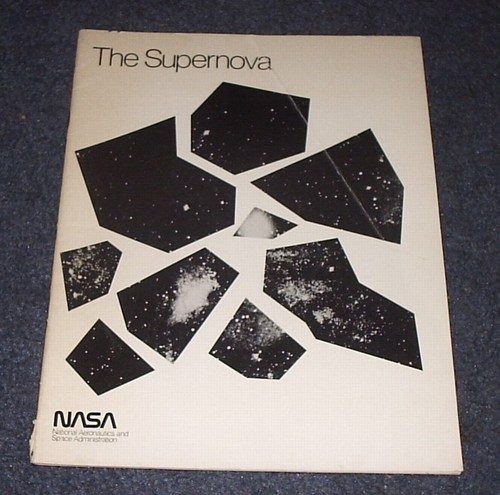
I stumbled across this teacher’s manual, published by NASA in 1976, part of a middle school curriculum that made the latest scientific understanding available to students.
Of all astronomical phenomena, supernova have been observed, if not understood, for thousands of years. Ancient Chinese astronomers apparently called them “guest stars.” So they make interesting markers for tracking the changing view of the vault of heaven/sky/space/universe.
It’s also kind of interesting to see how little was actually known about supernova, even during my lifetime.
But mostly, I liked this for the cover, which reminds me a bit of the London 2012 logo. The book was put out by NASA’s Educational Programs Division, but there’s no designer mentioned. The awesome, old “worm” logotype was, of course, designed by Danne and Blackburn.
PDF available: The supernova: A stellar spectacle, 1976 [ntrs.nasa.gov]
Category: etc.
Mack & Stack
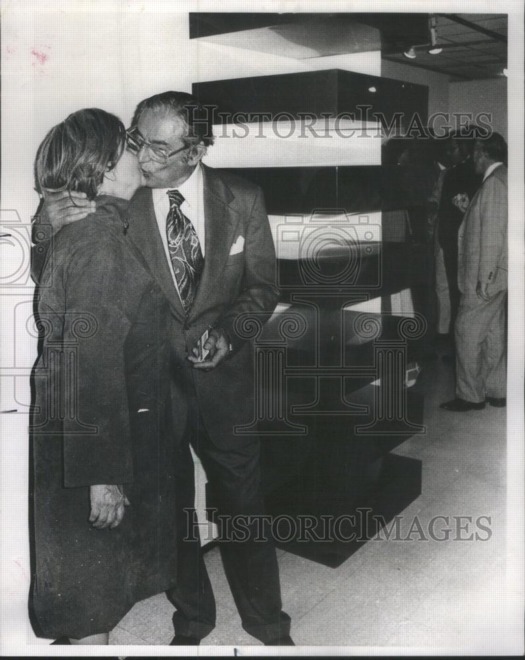
To Whoever Just Bought This Amazing 1977 Photo Of Founding Museum of Contemporary Art President Joseph Shapiro, Credit Card In Hand, Macking On His Lovely Wife Next To A Judd Stack,
Thank you. I’d been wanting it, but also not, being entranced but also slightly weirded out by it, and so hesitating over it for a couple of days now. I was about to cave. But tonight, I’ll give my extra $40 a little hug instead.
PS. If you ever Google your way across this, I’d love to do this photo justice with a better, watermark-free image, please.
Hövding Air Bag Bicycle Helmet Björk Björk Björk
 I don’t know where to plot this fashion show for Hövding, the amazing, new Swedish air bag bike helmet startup, on the grid containing the Blade Runner chase scene, bike messenger tribe, post-triathlon hangout, Otakon registration, and Walter Van Bierendonck, but it’s definitely on there somewhere. [via @timoarnall]
I don’t know where to plot this fashion show for Hövding, the amazing, new Swedish air bag bike helmet startup, on the grid containing the Blade Runner chase scene, bike messenger tribe, post-triathlon hangout, Otakon registration, and Walter Van Bierendonck, but it’s definitely on there somewhere. [via @timoarnall]
Philip Glass! Philip Glass! Philip Glass!
Oh, will you look at that. Right at the epicenter of the continent’s financial crisis, Banco Sabadell, a mid-sized Spanish bank, commissioned a flash orchestra to casually assemble with their instruments in front of their closed building on the plaza and to just toss off the last, best thing the European Union’s got going for it right now, its anthem, the prelude from Ode To Joy, Beethoven’s Ninth.
That always gets me right h–oh, wait, what’s that? NPR and WQXR organized a flash choir to perform Philip Glass–and to sing a specially commissioned adaptation by the composer himself, no less–for his 75th birthday, in the center of freakin’ Times Square?
Hah, in your FACE, Europe!
Flash Choir Sings Philip Glass In Times Square [npr.org]
Two Ships Passing In The Night
It’s not that I feel a need to apologize for breaking some imaginary overall narrative flow, but I just need to put these here for current and future reference.
First, the SS Leviathan, as seized from Germany and as outfitted in WWI-era Dazzle Camo livery:
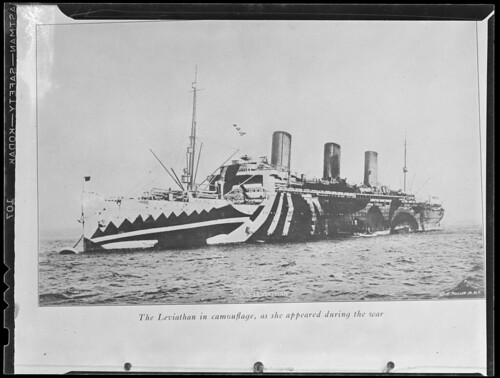
[boston public library’s flickr via proscriptus]

And then there’s the Lockheed Martin HALE-D, a next-generation military communications airship that obviously traces its design DNA back to the glorious Echo and PAGEOS satelloons of yesteryear. Unfortunately, like those ships, the HALE-D, and many of the inflatable, unmanned surveillance airships the Pentagon has burned $1 billion developing the last four years, have turned out to be an evolutionary dead end; the HALE-D crashed on its initial test flight, and the program is now on the chopping block.
Or Did Just Everyone Have A VW Bus And A Loft Back Then?
Seriously, people, maybe I should just start documenting the artists and avant garde music folks in the 1960s who didn’t roam around in a VW Bus. Here is composer Terry Riley, published in William Duckworth’s 1999 interview collection, Talking Music:
DUCKWORTH: When did you move to New York?
RILEY: I came to New York in 1965. After the In C performances, I went to Mexico on a bus for three months. I was actually looking for something, but I didn’t know what. I guess after In C, I was a little bit wondering what the next step was to be, you know. And I guess what I really wanted to do was go back and live in Morocco, because I was interested in Eastern music, and at that time, Moroccan music attracted me the most. I had lived there in the early sixties. In 1961, I went to Morocco and was really impressed with Arabic music. So we went to Mexico. My point was to get to Vera Cruz, put our Volkswagen bus on a boat and have it shipped to Tangier, and live in Morocco on the bus. We drove all the way down to Vera Cruz, but couldn’t get a boat; nobody would put our bus on the boat. So we drove all the way up to New York. We were going to try to do the same thing from New York, right? But I started hanging out with La Monte [Young] again and renewing old acquaintances. And Walter De Maria, who was a sculptor, had a friend who was leaving his apartment. THis guy had a fantastic loft on Grand Street. And he said, “Do you want to trade the loft for the bus?” So I did, and that began my four-year stay in New York.
Riley also had a wife and small kid at the time, and she supported the family by substitute teaching along their nomadic journeys. Amazing.
Previously: Walter de Maria’s stainless steel sculptures, including a musical instrument for La Monte Young, produced in 1965
The VW Years, Appendix: Living Theatre
Welcome to another episode of The VW Years, greg.org’s ongoing mission to seek out firsthand accounts of John Cage and Merce Cunningham’s VW Bus.
These are some mentions of John Cage in The Living Theatre: Art, Exile, and Outrage,, John Tytell’s 1995 history/biography of Living Theatre founders Judith Malina and Julian Beck, which were compiled by Josh Ronsen and posted to silence-digest, a Cage-related mailing list in 1998:
“At the end of September, they visited Cage and Cunningham who had expressed an interest in sharing a place that could be used for concerts and dance recitals. Gracious, unassuming, the two men lived in a large white room, bare except for matting, a marble slab on the floor for a table, and long strips of foam rubber on the walls for seating. The environment reflected their minimalist aesthetic. Cage proposed to stage a piece by Satie that consisted of 840 repetitions of a one-minute composition. He advised them not to rely on newspaper advertising, but to use instead men with placards on tall stilts and others with drums.” –pg 72
…
“the only person Judith admitted caring about was John Cage, “mad and unquenchable” with his “hearty, heartless grin.” With Julian, she visited Cage in Stoney Point in the Hudson Valley. … Julian thought Cage was the “chain breaker among the shackled who love the sound of their chains.” Cage collected wild mushrooms, which Julian interpreted as a tribute to his reliance on chance as much as to his exquisite taste. … [Paul] Williams wanted to help them find a new location that Cage and Cunningham could share with The Living Theatre.” -pg 121
“In the middle of 1957, they saw Cunningham dance at the Brooklyn Academy of Music to Cage’s music. At a party afterward, C&C laughed all night like “two mischievous kids who had succeeded in some tremendous boyish escapade.”” -pg 125
“[they] visited Cage in Stoney Point, where they made strawberry jam and gathered mint, wild watercress, and asparagus for dinner. Feeling a surge of confidence in his own writing, he [Julian] gave Cage a group of poems to set to music.” -pg 128
“With Judith, Julian, Cunningham, and Paul Williams, John Cage drove from “columned loft to aerie garage” in his Volkswagen bus, smiling despite the traffic and the fact that their search was now in its 4th month. Finally, they found an abandoned building, formally a department store on 14th st and 6th ave, which Williams declare would be suitable for sharing as a theatre and dance space.” – pg 129
“Early in December, with Cage’s assistance, [Cunningham] moved some of his backdrops into the space. Cage brought with him a variety of percussion instruments–he owned more than 300 at that time–which he donated to the theatre. Julian thought there was a distance about Cage that prevented intimacy and the fullest communication, but he felt Cage’s gift was a real sign of the artistic support that would be crucial to the success of The Living Theatre.” -pg 140
Is Shanzhai Still A Thing?
Its manifestations have been around and obvious for a while, but I can’t quite tell if shanzhai is played out, over, or still a thing. Shanzhai translates as “mountain fortress” when people want to emphasize its unregulated, somewhat pirate nature, but also “cottage,” when they want to highlight its backwoods, make-do lack of refinement.
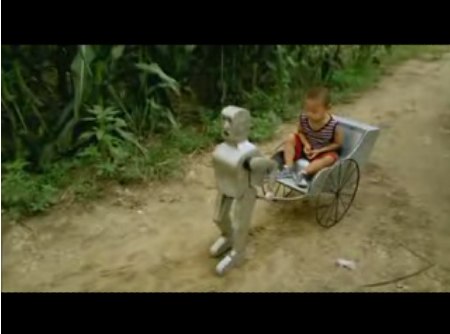
In 2007, Wu Yulu was making awesome homemade robots.
The Wall Street Journal hung its 2009 Shanzhai story on a wedding planner’s homebrewed, online-only sendup of CCTV’s Chinese New Year broadcast extravaganza, but in the context of a larger shanzhai trend that celebrated hacking, ingenuity, parody, and knockoffery:
On China’s Internet, blogs, bulletin boards and news sites carry photos of automobiles jerry-rigged to run on railroad tracks (“shanzhai trains”), fluffy dogs trimmed and dyed to look like the national mascot (“shanzhai pandas”) and models of the Beijing Olympic Games’ National Stadium made out of sticks (“shanzhai Bird’s Nest”).
A property developer in Nanjing, hoping to lure business and buzz, set up storefront facades with logos such as “Haagon-Bozs,” “Pizza Huh,” “Bucksstar Coffee,” “KFG” and “McDnoald’s.” Images of what became known as “Shanzhai Street” spread rapidly online.
The blog chinasmack has been my primary source for shanzhai, both for classic examples of pirated brands and electronics [including shots from that Shanzhai Street], but also for just flatout awesome DIYness like this 2009 video of “Shanzhai Drifter,” a kid who’s making smoke in his tricked out Changan delivery truck. Good times.
In 2010, at what might be the first simultaneous zenith and nadir of the contemporary art world’s engagement with shanzhai, Cai Guo-Qiang curated “Peasant da Vincis,” the inaugural show at the Rockbund Art Museum in Shanghai. The relentlessly corporate slickness of the monumental Shanghai World Expo was certainly ripe for questioning and deflation, if not direct criticism.
On the one hand, there were homemade planes and such. And Tao Xiangli did construct this insanely awesome scrap metal aircraft carrier, with shades of a folk art Serra or Burden. [image via the always comprehensive designboom]
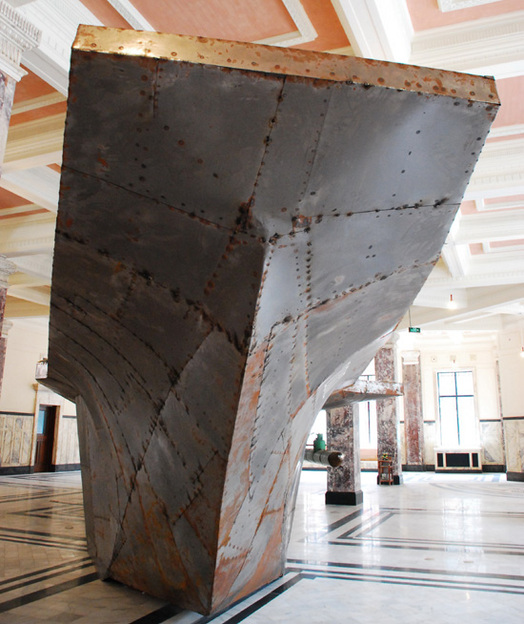
And sure, it’s good that Cai turned over an entire floor to Wu Yulu’s Robot Factory. But then Cai also commissioned Wu to make robot re-enactors of modern and contemporary artists at work. Like Yves Klein’s Living Brush?
And Jackson Pollock, and seriously, Damien Hirst? Doesn’t having to put a headshot of the artist your robot is mimicking automatically count as a fail?
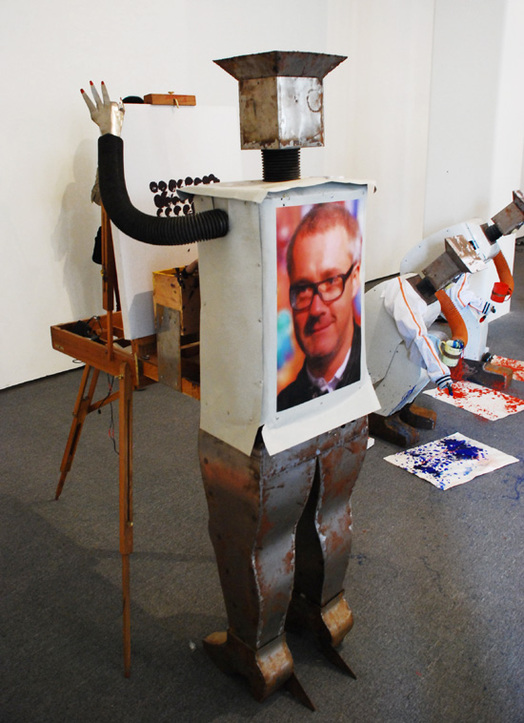
Designboom says the artworks these robots created were sold as limited editions. Which only exacerbates the apparently complete absence of Jean Tinguely from Cai & Wu’s Peasant da Vinci colabo. No excuse. [Wu Yulu’s status as the Peasant King of Export Shanzhai was cemented by his 2011 profile in Colors Magazine.]
Anyway, I grew concerned because in yesterday’s chinasmack roundup/translation of Hierarchies of Snobbery and Contempt by Chinese Netizens, the shanzhai option is consistently last in every category. Which, in one sense, sure, but in another, isn’t that the entire point?
The Grid-Sphere Satellite And The Doomsday Stone
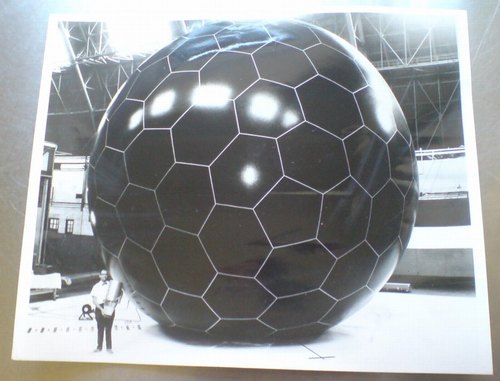
Last year I picked up this extraordinary photograph, and then didn’t have immediate results researching it, so I put it away until now. Then, wow.
NASA launched the first Project Echo communications satelloon in 1960 to much fanfare, but the 100-foot diameter inflated Mylar sphere’s actual performance as a reflective signal relay fell short of predictions. Echo IA launched in 1960 and stayed aloft and visible from earth until 1966, but it partially deflated within a few weeks, which weakened its reflectivity. And the drag of such a large object decayed its orbital speed in ways that made it an unreliable relay.
Soon after Echo II’s launch in 1964 by NASA and Bell Labs, the US Air Force began pursuing a next-generation technology with one of its leading military contractors, Goodyear Aerospace: the grid sphere.
The grid sphere satellite was designed, near as I can tell, by Goodyear Aerospace engineer Howard Barrett. The 30-food diameter sphere of rigidized, laminated aluminum wire was embedded in a UV-sensitive plastic, which would photolyze, or disintegrate, after inflating in space, leaving the open grid sphere intact. The sphere was calculated to produce a backscatter reflection signal more than 5x as powerful as the Mylar solid sphere three times its diameter, and would be immune to its puncture, deflation, and solar radiation drag effects.
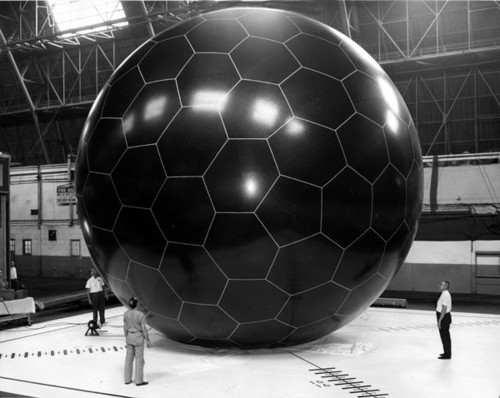
image via National Museum of the US Air Force
I’ve found mention of both 2-foot and 14-foot diameter grid sphere models, and another image of this 30-foot test inflation. Good gravy, did they really just inflate it using that tiny, leaf blower thing? I think it goes without saying, but I’ll say it anyway, that when it launched in 1966 from Vandenburg AFB on an Atlas rocket, the grid sphere satellite became the second-most beautiful object ever put into space. Between July 13, 1966 and May 24, 1968, when Echo IA burned up in the atmosphere, there were two satelloons and this open grid sphere, all orbiting the earth together, in Minimalism’s awesomest group show.
Which would be cool enough on its own. And then Andy Beach sends me this.
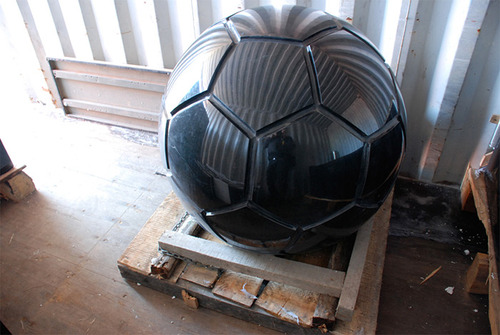
It’s Nicholas Mangan’s 2008 photo of Ed Grothus’s Doomsday Stone. Grothus was the atomic technician-turned-anti-nuclear peace activist-and-retail-icon who ran The Black Hole, the legendary military/scientific surplus store in Los Alamos, New Mexico. Grothus died in 2009 without being able to realize his decades-in-the-making Doomsday Stones memorial, a set of massive black granite obelisks carved with warnings in 15 languages about the destructive power of nuclear weapons.
The obelisks I’d heard about, but not this insanely awesome 1-meter, 1.5-ton, black granite sphere, which rests alongside them in a shipping container in Grothus’s backyard. Mangan:
In late 2007 Ed went to the Art in Public Places board in Los Alamos to offer them his monuments for public display. They rejected them stating that ‘they couldn’t think of anywhere in Los Alamos where they would fit in’. They backed up their rejection by claiming that Ed was not an ‘Artist’ according to their set of definitions and requirements.
There is something about a prophet in his own country here. Grothus’s Doomsday Stones are art in every sense of the word, and his work is an artistic practice of the highest kind, and should be recognized as such.
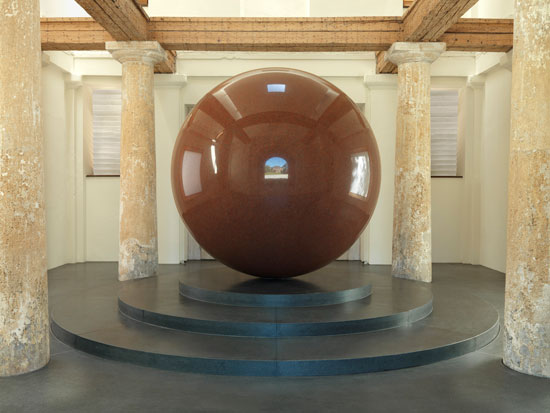
Large Red Sphere, Walter de Maria, 2010, permanent installation at Kunstareal, Munich, image: e-flux
The self-proclaimed art world ignores Grothus at the peril of its own credibility and relevance. If it’s just a matter of the research not being done, let’s get on it. If we need to inflate the critical balloon to give Grothus’s reputation the structure it is obviously meant to have, let’s start blowing. From his quixotic minimalist megalomania in the desert [Heizer, Turrell, De Maria] to his performative taunts in high Catholic regalia [Klein], to his fantastical historical dumpsterdiving [Dion], Grothus is Los Alamos’ own Simon Rodia. It’s just a question of how long it’ll take everyone to realize it.
Jonathan Monk Paperweight
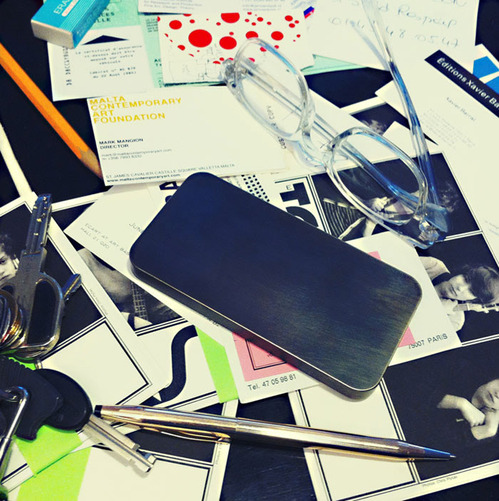
No amount of waiting in line can help me now. This awesome, bronze, iPhone-shaped paperweight by Jonathan Monk is sold out. I’ll console myself with the knowledge that had I heard about it in time, the goofy name would probably have been a dealbreaker anyway.
Call Weighting Paper, Jonathan Monk, ed. 12 +3 proofs, plus two boondoggle copies [onestarpress.com via artistsbooksandmultiples via stoppingoffplace]
Verner Panton X IKEA Chairs: Almost A Set
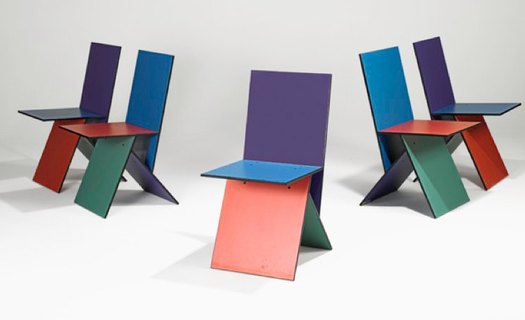
image: ragoarts
A couple–wow, almost three–years ago, when I was deep in my IKEA colabo phase, I posted a roundup of explanations for why Verner Panton’s melamine-on-MDF Vilbert chair didn’t sell that well when Ikea launched it in 1993-4.
Now, on the occasion of Rago’s upcoming auction of five Vilbert chairs, with an estimate of $3-4,000, another version of the chair’s origins has come to my attention: that the Vilbert was a limited edition, a low-production collaboration with a high-profile designer, dreamed up by Ingvar Kamprad as a brand enhancer, like Karl Lagerfeld’s H&M collection. In this scenario, selling only “about 3,000” Vilbert chairs worldwide was not a failure, but part of the plan.
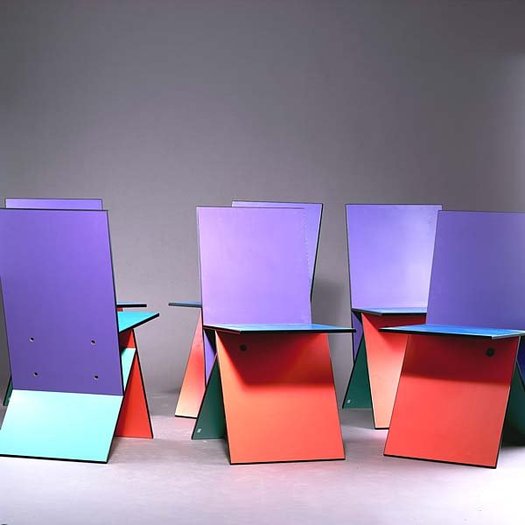
In any case, despite a lot of onesies selling–or not–for far less, I will guess that Rago hopes its set of five is worth twice the EUR 1600 Quittenbaum got for six Vilbert chairs in 2006. Perhaps someone with a chairless Guyton/Walker breakfast nook will prove them right.
UPDATE: the chairs sold for $2,875.
Death Watch
Alright, the mourning process seems to be ending, but the Guggenheim still hasn’t posted video of the crazy/awesome/all over the place speeches from “The Last Word,” the TED-like symposium marathon organized last weekend for the end of Maurizio Cattelan’s “All.” And for his supposedly looming retirement from artmaking.
So I’ve gone ahead and posted a Storify recap of the livetweet commentary I did, almost involuntarily, when I stumbled across the webcast, about mid-way through Francis Naumann’s discussion of Duchamp’s supposed retirement.
Let’s see if this works:
ORLY? Marine Hugonnier’s Art for Modern Architecture (Homage to Ellsworth Kelly)
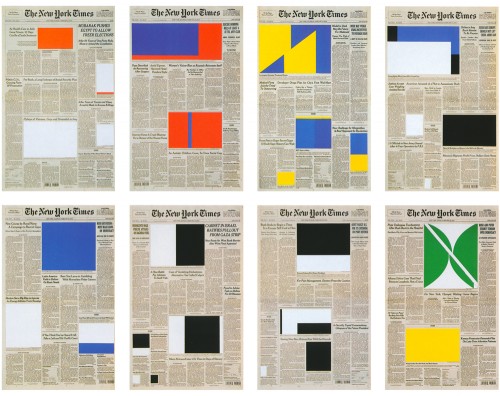
Marine Hugonnier, Art for Modern Architecture (Homage to Ellsworth Kelly), The New York Times (Week of February 21st to February 27th 2005)
Now this gets very interesting very quickly. Jason, a sharp-eyed greg.org reader in Paris, just sent along a link to a recent post on We Find Wildness about the very interesting work of Marine Hugonnier:
Art for Modern Architecture (2004-ongoing) investigates the role of the image, its abilities and its limitations and reverses the process by obstructing the press images on the front page of a week’s worth of newspapers (the series include The New York Times, The Times, Die Tageszeitung, Le Monde, The Herald Tribune, The Neue Zürcher Zeitung and Al Ayaam) with collages made of cutouts from ELLSWORTH KELLY’s book Line Form Color.
ELLSWORTH KELLY claimed that art was to be made for public spaces and buildings, thus establishing the modernist utilitarian project of art serving modern architecture. This project renews KELLY’S ideas and re-elaborates them within another medium, that of a newspaper, the ‘architecture’ of which frames everyday life.
Hugonnier’s series is not an unknown quantity by any means. Her 2007 Kellyfication of The Times of London, for instance, was acquired by MoMA in 2008. If Cornelius Tittel, the Welt’s culture editor responsible for the newspaper’s special all-Kelly edition somehow did not know of Hugonnier’s work, which is one of the more prominent contemporary examples of art that directly deals with newspapers as media, Kelly and/or his crew certainly knew. I would chalk this one up as a great idea that positively demanded to be realized.
FREAKY HUGONNIER-IN-THE-AIR UPDATE I just caught up with it now, but Ro/Lu also posted about Hugonnier’s Art for Modern Architecture series, including some gorgeous images of her more recent pieces, where she uses her own abstract cut-outs. Great minds &c., &c.!
Previously, and still definitely related, also, from 2003, so really, who even knows what kind of amazing material the guy’s got squirreled away? Ellsworth Kelly on Ground Zero
Wade’s Welt, Excellent
I stopped by a friend’s studio yesterday–which was fantastic, btw–and as I was leaving, and I noticed the cool, old Ellsworth Kelly exhibition poster in the bathroom, I so I was all, have you seen the Kelly edition of Die Welt, and he’s all, it’s fantastic, I just got it as a gift! and I’m all, right here right now? and he’s all, yeah, I just brought it in, do you want to see it? and I’m like, well, yeah, and he’s all, well, everyone should see it, Ellsworth’s so lucky, and then the adult in the room was all, you should have some white gloves, and then we had to figure out who was actually the best at turning the pages, and anyway, long story short, it’s completely incredible, and it would never happen in the US, but we all pretty much agreed that USA Today should do it. Can you even imagine it?
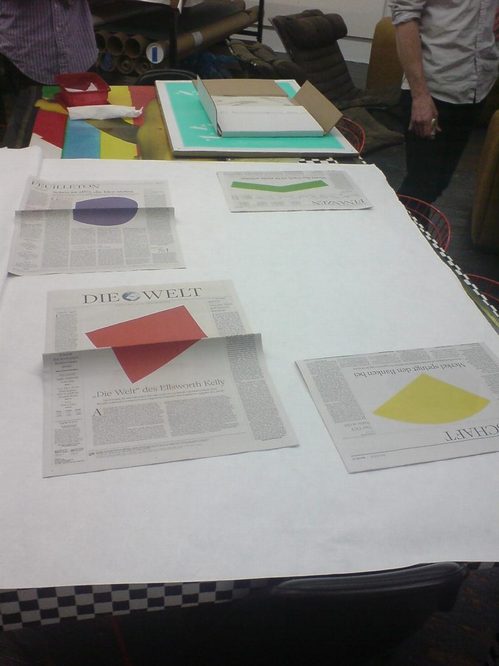
Moby Dick Typed On Toilet Paper
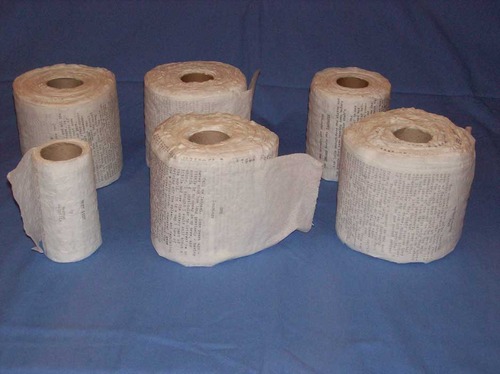
There is much to do, and much to write, but it’ll have to wait. Because right this minute, a copy of Moby Dick typed on six rolls of toilet paper is for sale on eBay:
MY FRIEND AND I ONCE JOKED THAT TOILET PAPER SHOULD HAVE INSTRUCTIONS PRINTED ON THEM FOR CERTAIN PEOPLE
ONE DAY, THE CONVERSATION GREW FROM THERE AND TURNED INTO A WAGER THAT I COULDN’T (OR WOULDN’T) BE ABLE TO TYPE OUT A NOVEL ON TOILET PAPER.
YES, WE DID HAVE SOME TIME ON OUR HANDS BUT, AS YOU CAN SEE BY THE FOLLOWING PHOTOS, I WON THE BET.
THERE ARE FOUR FULL ROLLS, ONE ROLL (EPILOGUE) IS ABOUT 1/5 OF A ROLL AND ONE HALF-ROLL
ALL OF THE ROLLS OF TP CAME OUT OF A BRAND NEW — CLEAN — PACKAGE OF 2-PLY COTTONELLE
THEY’VE BEEN HANDLED VERY GINGERLY AND INFREQUENTLY
AS YOU’LL SEE IN THE FOLLOWING PHOTOS, ONE OR TWO ROLLS HAVE A TEAR AT THE BEGINNING
THIS IS WHERE I WAS TRYING TO PULL THE PAPER THROUGH THE TYPEWRITER
I’VE KEPT THIS MOD ODDITY IN A BOX IN A COOL, DRY PLACE FOR THE LAST 10 YEARS
AND HAVE ONLY BROKEN IT OUT TO PROVE TO DOUBTERS THAT I ACTUALLY DID IT
CONSIDERING WHAT IT’S BEEN THROUGH, IT’S IN AMAZING CONDITION
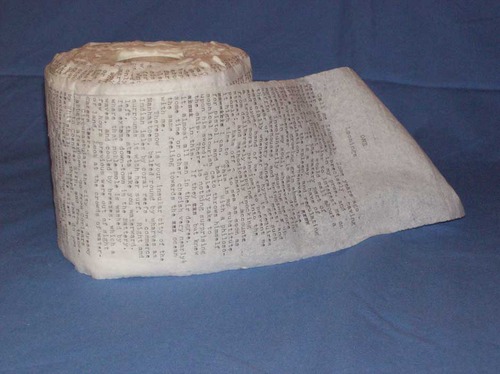
I mean, there’s so much we still don’t know. Like who did it? In this day of Facebook non-privacy, how can an artist be known simply as The Toilet Paper Moby Dick Master? And how long did it take? Wait, before that, even, what, really, was this conversation that led to this bet? And how did the bet end up involving one of the longer novels in the canon? Why not something shorter? Something like On The Road?
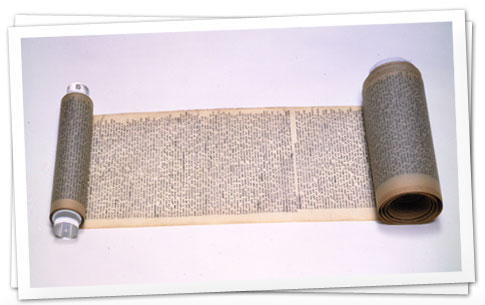
Moby Dick typed on toilet paper, opening bid, $399.95 plus free shipping, auction ends Jan. 29 [ebay via @cthon1c]
Kerouac Scroll Tour [ontheroad.org]
UPDATE: since posting this, the opening bid has been raised, appropriately, to $999.95.
UPDATE UPDATE: or one like it. “The seller has relisted this item or one like it.”
PRICELESS UPDATE: On the one hand, especially if I were the one who had typed it, and protected it in a shoebox all these years, I would KNOW KNOW that $320 is a ridiculous insult of a result. How dare eBay? On the other hand, there were four bidders on this thing, so, not entirely unnoticed. The Master Of The Typed On Toilet Paper Moby Dick needs to keep it and turn it into a family heirloom, or he needs to let it go, and let the world–and specifically, the knucklehead(s) contemplating spending several hundred dollars for it–take care of it.
